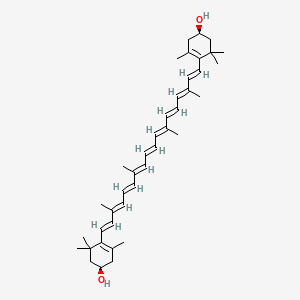| Brady WE et al. |
Human serum carotenoid concentrations are related to physiologic and lifestyle factors. |
1996 |
J. Nutr. |
pmid:8558292
|
| Büch K et al. |
FAD is a further essential cofactor of the NAD(P)H and O2-dependent zeaxanthin-epoxidase. |
1995 |
FEBS Lett. |
pmid:8521963
|
| Leo MA et al. |
Differential depletion of carotenoids and tocopherol in liver disease. |
1993 |
Hepatology |
pmid:8514270
|
| Jørgensen K and Skibsted LH |
Carotenoid scavenging of radicals. Effect of carotenoid structure and oxygen partial pressure on antioxidative activity. |
1993 |
Z Lebensm Unters Forsch |
pmid:8511974
|
| Bone RA et al. |
Stereochemistry of the human macular carotenoids. |
1993 |
Invest. Ophthalmol. Vis. Sci. |
pmid:8491553
|
| Reddy KJ et al. |
Characteristics of membrane-associated carotenoid-binding proteins in cyanobacteria and prochlorophytes. |
1993 |
Meth. Enzymol. |
pmid:8469150
|
| Peng YM et al. |
A nonsaponification method for the determination of carotenoids, retinoids, and tocopherols in solid human tissues. |
1993 Mar-Apr |
Cancer Epidemiol. Biomarkers Prev. |
pmid:8467248
|
| Levy H et al. |
Cbr, an algal homolog of plant early light-induced proteins, is a putative zeaxanthin binding protein. |
1993 |
J. Biol. Chem. |
pmid:8407922
|
| Ojima F et al. |
Consumption of carotenoids in photosensitized oxidation of human plasma and plasma low-density lipoprotein. |
1993 |
Free Radic. Biol. Med. |
pmid:8225019
|
| Biswal B et al. |
Changes in carotenoids with nitrogen stress in the cyanobacterium Synechococcus PCC6301. |
1993 |
Biochem. Soc. Trans. |
pmid:8132041
|
| Sowell AL et al. |
Retinol, alpha-tocopherol, lutein/zeaxanthin, beta-cryptoxanthin, lycopene, alpha-carotene, trans-beta-carotene, and four retinyl esters in serum determined simultaneously by reversed-phase HPLC with multiwavelength detection. |
1994 |
Clin. Chem. |
pmid:8131277
|
| Weiser H and Kormann AW |
Provitamin A activities and physiological functions of carotenoids in animals. Relevance to human health. |
1993 |
Ann. N. Y. Acad. Sci. |
pmid:8129293
|
| Stacewicz-Sapuntzakis M et al. |
Serum reference values for lutein and zeaxanthin using a rapid separation technique. |
1993 |
Ann. N. Y. Acad. Sci. |
pmid:8129291
|
| Schubert H et al. |
In vivo manipulation of the xanthophyll cycle and the role of zeaxanthin in the protection against photodamage in the green alga Chlorella pyrenoidosa. |
1994 |
J. Biol. Chem. |
pmid:8125939
|
| Gilmore AM et al. |
Epoxidation of zeaxanthin and antheraxanthin reverses non-photochemical quenching of photosystem II chlorophyll a fluorescence in the presence of trans-thylakoid delta pH. |
1994 |
FEBS Lett. |
pmid:8070578
|
| Wahlqvist ML et al. |
Changes in serum carotenoids in subjects with colorectal adenomas after 24 mo of beta-carotene supplementation. Australian Polyp Prevention Project Investigators. |
1994 |
Am. J. Clin. Nutr. |
pmid:7985637
|
| Sarry JE et al. |
The protective function of the xanthophyll cycle in photosynthesis. |
1994 |
FEBS Lett. |
pmid:7926040
|
| Franke AA et al. |
Effects of micronutrients and antioxidants on lipid peroxidation in human plasma and in cell culture. |
1994 |
Cancer Lett. |
pmid:7910514
|
| Küçük O et al. |
Increased plasma level of cholesterol-5 beta,6 beta-epoxide in endometrial cancer patients. |
1994 Oct-Nov |
Cancer Epidemiol. Biomarkers Prev. |
pmid:7827587
|
| Woodall AA et al. |
Antioxidant activity of carotenoids in phosphatidylcholine vesicles: chemical and structural considerations. |
1995 |
Biochem. Soc. Trans. |
pmid:7758698
|
